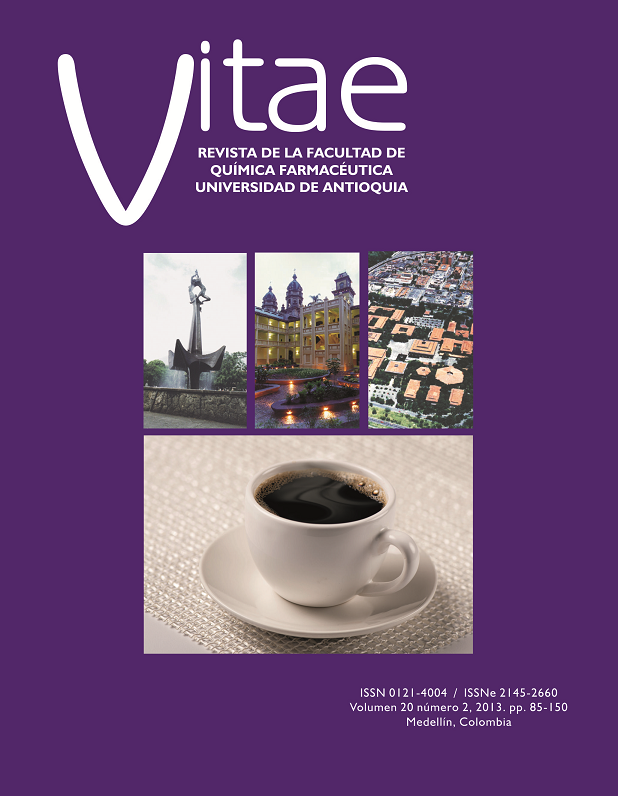Puesta a punto de un método analítico mediante cromatografía de gases para la determinación del perfil lipídico en carnes
DOI:
https://doi.org/10.17533/udea.vitae.13875Keywords:
Ácidos grasos, carne, derivatización, cromatografía de gasesAbstract
Antecedentes: La caracterización y cuantificación de perfiles lipídicos, por medio de cromatografía de gases, permite establecer las características nutricionales y propiedades funcionales de los ácidos grasos presentes en los alimentos. Sin embargo, en la determinación de perfiles lipídicos existen varias condiciones que afectan su cuantificación; además, en los métodos analíticos utilizados para la determinación de perfiles lipídicos en matrices cárnicas no se dispone de un consenso sobre las etapas de extracción y derivatización. Objetivos: Evaluar las mejores condiciones para la cuantificación de ésteres metílicos, variando la cantidad de muestra cárnica y el volumen de metóxido de sodio o trifluoruro de boro, empleados en la etapa de derivatización de un método analítico utilizado para la determinación de un perfil lipídico en carnes bovinas. Métodos: Las condiciones evaluadas fueron: el tipo y la cantidad de reactivos de derivatización (metóxido de sodio 250 µL y 500 µL; trifluoruro de boro 700 µL), cantidad inicial de muestras cárnica (3,0 y 6,0 g) y extracción de grasa según método Folch et al., 1957 (9). La derivatización de triglicéridos y metilación de ácidos grasos tuvo una reacción de 45 minutos para metóxido de sodio y 15 minutos para trifluoruro de boro. Finalmente, la cuantificación de los ésteres metílicos de los ácidos grasos se hizo con un cromatógrafo de gases Agilent 7890ª (Agilent, USA), empleando un detector FID. Resultados: No se encontraron diferencias estadísticamente significativas (p > 0,05) al comparar las combinaciones entre cantidades de muestras, tipo y volumen de reactivos de derivatización empleados. Se encontraron valores de esteres metílicos de ácidos grasos (%P/P) saturados de 58,694% ± 2, monoinsaturados de 33,999% ± 2,4 y poliinsaturados de 7,304% ± 2,8. Conclusiones: La cuantificación de los ésteres metílicos de ácidos grasos en carne bovina por cromatografía de gases demostró ser eficiente y no se encontraron diferencias estadísticas al comparar la cantidad de muestra cárnica, el tipo de reactivo (metóxido de sodio o trifluoruro de boro) y volumen de reactivo empleados en la etapa de derivatización. La mayoría de los ácidos grasos cuantificados reportan valores similares para ese mismo tipo de posta cárnica.Downloads
Downloads
Published
How to Cite
Issue
Section
License
Copyright Notice and Open Access Statement
The Journal Vitae works under the Open Access license, and the published manuscripts remain available for the public, both on the Journal's website and in databases, under the Creative Commons license, "Noncommercial Attribution" and "Share alike" systems, adopted in Colombia. Hence, when the authors agree to publish in the Journal Vitae, they will not have the right to economic retributions on publications and reproductions through different diffusion media. The documents are freely available to the internet public, permitting users to read, download, copy, distribute, print, search, or link to the full texts and pass them as data to software. The only constraint on reproduction and distribution, should be to give authors control over the integrity of their work and the right to be appropriately acknowledged and cited.
Authors declare that:
-
They are the intellectual property owners and are responsible for all the information stated in the article.
-
This manuscript has not been submitted or published in other printed or digital media. They accept the responsibility for the judgments, opinions, and points of view expressed in the published article and, therefore, they exonerate Universidad de Antioquia and Journal Vitae from any process.
-
They exempt Universidad de Antioquia and Journal Vitae from settling conflicts or disputes related to the authorship of the referred article.
-
They accept the revision of the original manuscript by suitable personnel, and they bind themselves to perform the corrections appointed or suggested by the assessors.
-
Therefore, they know the editorial process and will not bind the Editorial Board of the Journal to assume any obligations regarding the volume and issue in which the article is published.
-
They transfer the rights of publication, reprinting, and distribution of the article from the moment of its approval, in print and digital format, without the right to economic rewards, and under the licensing conditions considered relevant by Journal Vitae.
-
They fully authorize Universidad de Antioquia and Journal Vitae to submit the published material to the diverse databases and indexing systems where the Journal can be found to comply with the requirements of the regulatory authorities to maintain the national classification of journals.
-
They will assume the article publication costs established for the current issue, and they will make the payment as soon as they are informed about the volume and the issue in which the final version of the article is published.
-
After the article is published, you can share digital or printed copies in a noncommercial manner. You will be able to use the paper in your institution or company for educational or research purposes, including the use in course programs.
Conflict of interest: Authors are responsible for recognizing and disclosing any financial or other benefits that could be perceived to bias their work, acknowledging all financial support and any personal connections with potential sponsors. Examples of such conflicts include receiving research funds or honoraria, serving on advisory boards, stock ownership, or employment and consulting arrangements. Authors without such connections should clearly state that they have no financial support or personal relationships that could be perceived to bias their work. All conflicts of interest should be disclosed on the author's identification page of the manuscript.










